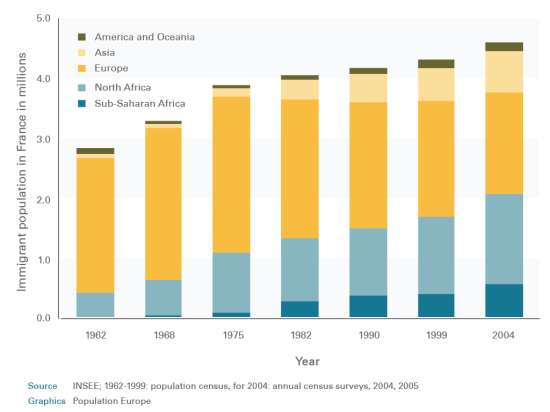The new receiving countries, Italy and Spain
The researchers take a closer look at the existing data about migration from sub-Saharan countries to Europe. Even in Spain and Italy, the countries now favored by these migrants, their numbers are still low. They account for just under 4% of the immigrant population in Spain and just under 8% in Italy. In both countries they are clearly outnumbered by immigrants from Europe, North Africa and Latin America (in Spain) or Asia (in Italy). (See table 1)

Table 1: The immigrant population of Spain and Italy by region of birth, 2006
France and Great Britain have a much longer tradition of being destinations for migrants from West and East Africa. But even there, as Lessault and Beauchemin point out, their share of the total immigrant population is relatively low. According to data from France, in 2004 sub-Saharan Africans accounted for 12% of the total immigrant population, whereas three times as many originate from Europe or North Africa. (see graph 1)

Graph 1: The immigrant population in France by region of origin, 2004
According to the researchers, the perceived increase of this immigrant group in Europe might well be due to the fact that it was virtually nonexistent in the past. In France there were only 20,000 sub-Saharan immigrants counted in the census of 1962; in other European countries their numbers have been even lower. In 2004, their number had reached 570,000, which is still less then 1% of the total French population.
The impact of undocumented migration
One of the big concerns in political and public debates is that this picture is distorted as undocumented migrants slip through the statistical net. According to Lessault and Beauchemin this is only partly true. First of all, immigrants who originally arrived without valid documents might well become legal residents at a later stage. This is especially likely when political measures such as the French regularisation programme from 1997/98, and similar programmes in Spain and Italy encourage this. In the latter two countries figures of these programmes again show decreasing proportions of people from sub-Saharan countries: In Italy their share in regularisation programmes decreased from 14% in 1998 to 5% in 2002, in Spain from 14% to 7% in 2001.
Of course, not all undocumented migrants apply for regularisation, and not all applications are successful. Using figures from the French programme, the researchers assume that for the 42,000 applications submitted by sub-Saharan Africans, a similar number of individuals did not apply. Adding these numbers to the individuals counted in the census of 1999 still does not increase the statistics significantly: The proportion of sub-Saharans in the total immigrant population rises from 9% to less than 11%.
Most African Migrants stay on the continent
The researchers conclude that even when undocumented cases are included, migration from sub-Saharan countries is a recent and limited trend. This is largely because only a few people from that region migrate from Africa at all. Even the many refugees from conflict in the region tend to stay on the African continent. According to a compilation of census data used by Lessault and Beauchemin, fewer than one in a hundred people (0.9%) born in that area and aged 25 or over in 2000 lived in an OECD country. That is thirteen times less than the proportion of sub-Saharan immigrants living in Central America (11.9 %). Additionally, the political and public debates ignore that significant numbers of the relatively few that come to Europe only stay for a limited period of time.
This PopDigest is also available in French, Spanish and German.
This volume has been published with financial support of the European Union in the framework of Population Europe.